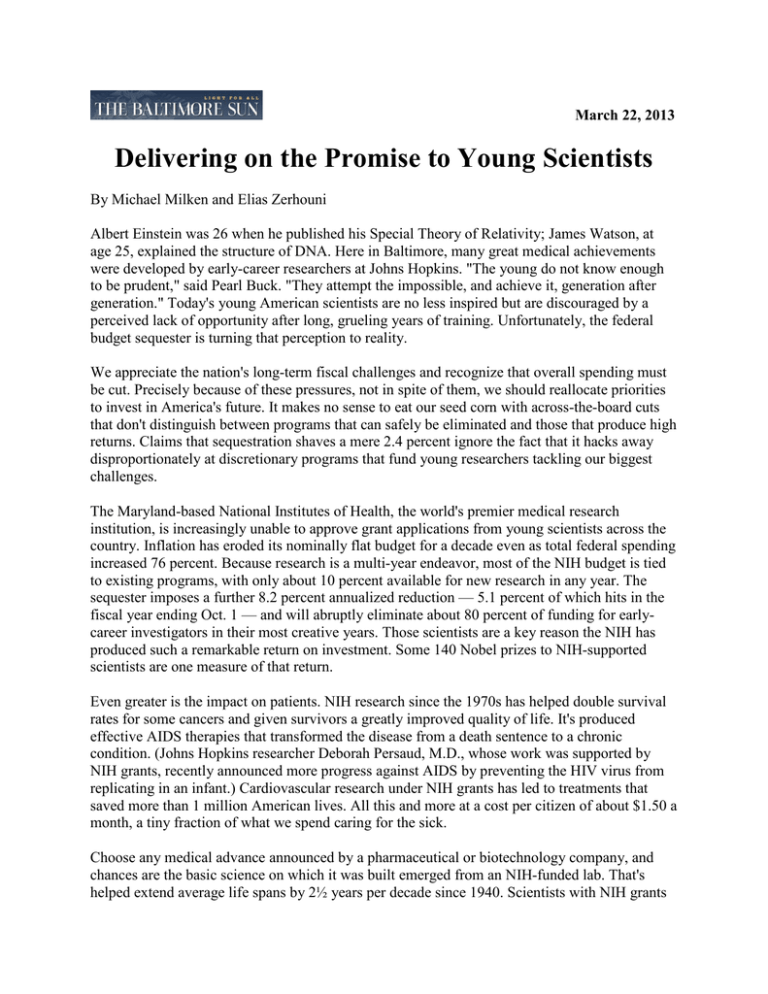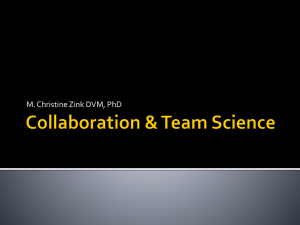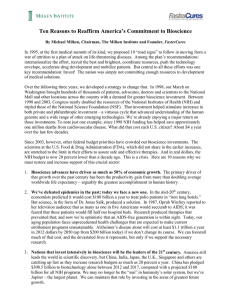Delivering on the Promise to Young Scientists
advertisement

March 22, 2013 Delivering on the Promise to Young Scientists By Michael Milken and Elias Zerhouni Albert Einstein was 26 when he published his Special Theory of Relativity; James Watson, at age 25, explained the structure of DNA. Here in Baltimore, many great medical achievements were developed by early-career researchers at Johns Hopkins. "The young do not know enough to be prudent," said Pearl Buck. "They attempt the impossible, and achieve it, generation after generation." Today's young American scientists are no less inspired but are discouraged by a perceived lack of opportunity after long, grueling years of training. Unfortunately, the federal budget sequester is turning that perception to reality. We appreciate the nation's long-term fiscal challenges and recognize that overall spending must be cut. Precisely because of these pressures, not in spite of them, we should reallocate priorities to invest in America's future. It makes no sense to eat our seed corn with across-the-board cuts that don't distinguish between programs that can safely be eliminated and those that produce high returns. Claims that sequestration shaves a mere 2.4 percent ignore the fact that it hacks away disproportionately at discretionary programs that fund young researchers tackling our biggest challenges. The Maryland-based National Institutes of Health, the world's premier medical research institution, is increasingly unable to approve grant applications from young scientists across the country. Inflation has eroded its nominally flat budget for a decade even as total federal spending increased 76 percent. Because research is a multi-year endeavor, most of the NIH budget is tied to existing programs, with only about 10 percent available for new research in any year. The sequester imposes a further 8.2 percent annualized reduction — 5.1 percent of which hits in the fiscal year ending Oct. 1 — and will abruptly eliminate about 80 percent of funding for earlycareer investigators in their most creative years. Those scientists are a key reason the NIH has produced such a remarkable return on investment. Some 140 Nobel prizes to NIH-supported scientists are one measure of that return. Even greater is the impact on patients. NIH research since the 1970s has helped double survival rates for some cancers and given survivors a greatly improved quality of life. It's produced effective AIDS therapies that transformed the disease from a death sentence to a chronic condition. (Johns Hopkins researcher Deborah Persaud, M.D., whose work was supported by NIH grants, recently announced more progress against AIDS by preventing the HIV virus from replicating in an infant.) Cardiovascular research under NIH grants has led to treatments that saved more than 1 million American lives. All this and more at a cost per citizen of about $1.50 a month, a tiny fraction of what we spend caring for the sick. Choose any medical advance announced by a pharmaceutical or biotechnology company, and chances are the basic science on which it was built emerged from an NIH-funded lab. That's helped extend average life spans by 2½ years per decade since 1940. Scientists with NIH grants established the foundation for human genome sequencing — a magnificent achievement that led to precision medicine. As a result, doctors can increasingly target disease with more exact and effective treatments designed for your particular genomic profile. Today, the rising costs of Alzheimer's disease and other age-related chronic conditions threaten to leave us with bleak choices between widespread suffering and financial ruin. We're optimistic that research will solve this challenge. But whether solutions are developed in U.S. laboratories or elsewhere will depend on our ability to prepare young scientists for global leadership. Any nation failing to support them will find it increasingly difficult to catch up. Our commitment to the future starts with STEM (science, technology, engineering and math) education and carries through to funding by the NIH, the National Science Foundation (NSF) and other research agencies. That's not a faucet that can be turned on and off. And at the other end of the development pipeline, sequestration threatens to delay review of new therapies by the Food and Drug Administration, the Silver Spring-based agency that protects public health. Meanwhile, Singapore, the U.K., Japan, South Korea, China, India and others are increasing research budgets as much as 20 percent a year. China, whose economy is less than half the size of ours, has pledged $308.5 billion just to biotechnology research over the next five years, compared with a projection of less than $200 billion for all programs of the NIH and NSF combined. Funding newly trained scientists is not an entitlement, a bet on unproven technologies or a mere expense. As Congress continues to debate national priorities, it is not too late to reverse dangerous cuts and reaffirm America's strategic investment in our future health and prosperity. Michael Milken is chairman of FasterCures, the Milken Institute center for accelerating medical solutions. Dr. Elias Zerhouni, the former director of the National Institutes of Health and a former Johns Hopkins medical dean, is president of global research and development at Sanofi.





